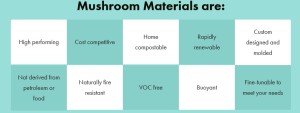
The Easter bunny, edible spoons, and mushroom materials.
My son and I colored Easter eggs yesterday, finally using a natural method to do so instead of buying the infamous PAAS kits for coloring, marbling, tie-dying or what have you. It took longer to do, boiling eggs in various color rendering food stuffs such as purple cabbage (blue), beets (pink), turmeric (yellow) and onion skins (copper brown). What struck me is that we need to appreciate and allow the greater production time if we are to achieve health and sustainability in products. These eggs are totally safe to eat and the shells will not harm our compost bins and resultant soil. The waste from the dying is water and vegetable remnants which are fine also for our compost. The Easter Bunny would be proud.
This made me realize that we do many, many things for single use or one event and, when that thing is discarded or that event is done, the wastes stick around for way too long, even forever. This blog is about two companies changing that.
Plastic utensils and cups are by far two of the most ridiculous “single use” products created, on par with single use water bottles, which should only be used for emergency supply situations. For the price of never-degrading petroleum-based waste, we have the convenience of buying something new every time we have a picnic or a dinner we don’t want to wash up after, and we have to haul and manage the waste. Now, before you say “but there are corn-based plastics that compost” let me point out that most bio-based plastics for cups and for utensils claim bio-degradable, but they are only degradable in industrial composting situations that have higher heat through introduction of heat (energy use) or through temperature managed larger piles of composting materials. Not your average backyard composting bin.
So, what can we do?
Edible utensils:
Check out this wonderful company that makes edible spoons. This is the right way to produce anything single use – make it so that when we discard the product, it does not create any problems. We need products that emulate nature. Read Cradle to Cradle by Michael Braungart and William McDonough. Their example of a cherry tree and how it produces hundreds of thousands of blossoms is enlightening. Though only a few of the blossoms will produce new trees, there is no waste as the rest will be food for bugs, soil, etc. Not only no harm, but great benefit. We need to change our goals from being “efficient” (one thing, one result, no waste in that linear process, highly controlled) to “effectiveness” (one thing relating to optimal performance and all the “waste” is of use to other processes, with little limiting control).
These spoons are shelf stable for three years which is good for retail establishments and for having a box or two available at home. They will bio-degrade in a couple of days if dropped which is great for the planet, as there is no “away”. Manufactured from grains, which are rapidly renewable, these spoons are not using up fossil fuels or created by toxic chemical constructs. They cost about $4 per 100. Spread the word.
Naturally degradable “foam” packaging:
Another made-from-petroleum product that is quite often single use is foam packaging. Yes, in some cases there is a “safer” foam mix that uses a less GHG intensive propellant to create the foam, and maybe reduces the use of petroleum by swapping it out for soy oils, but this “greener” foam is more typical in building products. And, once you do the math, the mix is around 7% soy overall. As a qualifier I am a BIG FAN of energy efficiency, and foam in buildings can help achieve high-efficiency, and if we use foam anywhere, best we use it in construction that is long-term, say 100 years plus. Not in “disposable” coffee cups and packaging. I am hoping we’ll move to more natural materials even in buildings, such as mineral wool and cellulose.
Back to packaging. One of the most exciting companies I know of is Ecovative, founded by a couple of RPI students about 10 years ago just outside of Troy, NY. Their original concept was to replace building foam insulation with grown insulation. This biomaterial is actually a composite of agricultural waste (seeds, straws, husks, etc.) held in a matrix grown from mycelium, which is the root system of mushrooms. They didn’t have great early success in the building industry as perceptions are tough to change and the idea of fungus in the walls (misperception) was hard to overcome. But in the packaging industry, look out. They can grow this biomaterial to any predetermined shape, and Dell uses their packaging to ship servers, and Crate & Barrel ships their home décor products using mushroom materials. Recently IKEA has announced use of Mushroom Packaging, which could, quite frankly, change the world.
Mushroom Materials takes about two weeks to grow in the forms and then to stop the growth reaction they dry out the mycelium. My favorite part of this product is comparing the process of its creation to that of petroleum-based foams. Petroleum is a fossil fuel, which takes hundreds of thousands of years for nature to produce, at minimum. Then we extract it, process it and make it into foam and other plastics. Once used, the foam is sound and will not degrade for a million years, plus or minus a few thousand years. This is not rhetoric. It can break down into smaller pieces that can choke animals and we have all seen it polluting waterways and roadsides. Ecovative has designed Mushroom Materials for a short life of use. Their first mycelium spores are protected and available for additional growth (and there are plenty in any forest). The growth in the forms takes only two weeks, and the finished foam, once used, can be broken up and placed in a compost bin or directly round plants to compost, and it aides in moisture retention and subsidizes the soil composition. It does not say on the Ecovative website how long it takes to to decompose, and I’m sure there are differences depending on the agricultural waste used and the density of the material. I have personally broken up some mushroom materials and placed them in my garden and have seen no sign of them in less than two weeks. The matrix goes first, and the “aggregate” of agricultural waste takes a bit longer to degrade.
So, again, this is an excellent example of how we will improve shipping by using mushroom materials and other absolutely biodegradable packing components. I receive my package from IKEA (or, let’s hope, from Amazon in the not-too-distant future, wouldn’t that be great) and I take out my cool new lamp pieces and read the assembly instructions. I break down and flatten the certified Cradle to Cradle box for recycling (thank you to the USPS for certifying your boxes) or keep it for re-use if it is a good size. I take the bio-foam and crumble it into my compost bin or strew it around my garden. Nothing to throw away, less guilt in purchasing my cool new lamp, and a solution that creates no new problems. Ecovative, I think I love you.
I see our future – our future of single use products that finally embrace that they MUST be made of materials that only last in their current form as long as we need them to, and that they must degrade without introducing toxins into our soil, water or air. Recycling is great, but it’s another process with faults and failings and less than perfect implementations. Let’s skip that part and make materials, especially single use materials, correct from the outset.
Tell your friends, and be greener!
Jodi
Be the first to like this post (no login required)

